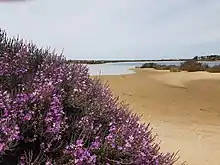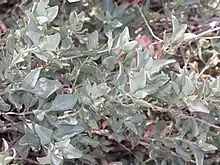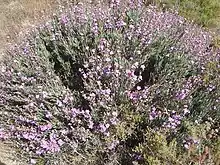Limoniastrum monopetalum
Limoniastrum monopetalum ('grand statice'), is a species of flowering plant in the family Plumbaginaceae that is native to between Europe, Northern Africa and Western Asia. It has been found in salt marshes, dunes and other coastal areas with high salinity levels. It has silver-grey or light green leaves on multi branching stems. At the ends of the stems are the summer blooming flowers, in shades of pink, purple, lavender and violet. It is known to be salt and drought tolerant (as a Halophyte), as well as having the ability to withstand some forms of soil pollution.
| Limoniastrum monopetalum | |
|---|---|
 | |
| Limoniastrum monopetalum in Ria Formosa, the Algarve, Portugal | |
| Scientific classification | |
| Kingdom: | Plantae |
| Clade: | Tracheophytes |
| Clade: | Angiosperms |
| Clade: | Eudicots |
| Order: | Caryophyllales |
| Family: | Plumbaginaceae |
| Genus: | Limoniastrum |
| Species: | L. monopetalum |
| Binomial name | |
| Limoniastrum monopetalum | |
| Synonyms[1] | |
| |
Description

Limoniastrum monopetalum is a small evergreen shrub,[2][3] that has long thread-like and tufted fine roots, with ephemeral roots that are produced in a wet season and then vanish afterwards. The wide spread of the roots helps the plant withstand the high salinity conditions and they can also travel down to at least 50 cm to reach the water table.[4]
It can grow up to 90–120 cm (35–47 in) tall,[5][6][7] with much branched,[6][7] and leafy stems.[5][8] They are terete (round in cross-section) and grey in colour.[5] The leaves are normally at the top of the branches, leaving the base of the branch, bare with leaf scars.[9]
It has light green,[10] green-grey,[11] or silvery blue-green,[7] leather-like,[8] stiff, narrowly spathulate (spoon-shaped) leaves.[12][11] They are covered with white granulations;[9] calcareous (carbonate deposits[9]) tubercles.[12] This gives the plant a whitish grey aspect.[12]
It blooms between mid-Spring and early Summer.[3][7] Variously; between March and November,[9] between July and August,[10] or June to August.[6] The numerous flowers,[7] come in shades of pink,[6][9] lavender pink,[13] purple-pink,[10][7] or lavender flowers.[3] As they die they fade to violet.[9][11]
They have articulated rachis (spine) and tubular[9] or funnel-shaped corolla (the petals of a flower),[8] they appear at the ends of the branches.[6][7][11] They have leathery bracts, the external sepals are 2.5–7 mm and the internal sepals are 7.5–9 mm long, scarious (dry and membranous), covered almost entirely by the internal bract. It also has 5 stamens.[9]
After flowering it produces a fruit (or seed capsule), which is membranous, indehiscent and included in the calyx.[9]
Biochemistry

It is a halophyte plant,[8] and the leaves of Limoniastrum monopetalum have been studied to determine how the plants phenolic contents and biological activities coped with various solvent effects.[14][15]
In 2014, the salt excretion crystals on the leaf surface of the plant were studied as a possible metal detoxification mechanism.[16]
Taxonomy
_(20552012764).jpg.webp)
It is known in Mali as 'zeïta' and 'zita' in Arabic.[5] It is known in Spanish as 'Salado' or 'Verdolaga seca',[17] and in Catalan as 'Ajocagripaus'.[6]
It has the common name of 'Grand statice',[8][18] (reflecting the former name of the genus).
The Latin specific epithet monopetalum derived from 'monopetalus',[9] and refers to 'mono' and 'petal' meaning one petal.[19]
Using an earlier description by Carl Linnaeus when he had named it as Statice monopetala in his book Species Plantarum in 1753.[20] After the genus Statice was re-classified as 'Limoniastrum', it was then first published as Limoniastrum monopetalum (L.) Boiss by Pierre Edmond Boissier in 'Prodromus Systematis Naturalis Regni Vegetabilis' Vol.12 on page 689 in 1848.[21]
It was verified by United States Department of Agriculture Agricultural Research Service on 9 August 1995, as Limoniastrum monopetalum,[22] and it is an RHS Accepted name and was last-listed in the RHS Plant Finder in 2016.[23]
Distribution and habitat

Limoniastrum monopetalum is native to temperate areas between Europe, Northern Africa and Western Asia.[22]
Range
It is found in Europe, in the Mediterranean countries of Portugal,[23][24] Corsica,[8] Spain, France, Greece,[1][25] Balearic Islands of Mallorca and Menorca,[6] and Italy (incl. Sardinia and Sicily).[22] Within North Africa and Asia,[5] it is found in Algeria, Libya and Egypt.[22][26]
It has been introduced to Morocco and Tunisia.[22][27]
Since 1995, it has been found in the Canary Islands.[28]
Habitat
In Egypt, it is found in salt marshes,[24][29] coastal sand dunes and rocky ridges habitats.[6][26] It is also found in the dunes of the salt marsh around Lake Manzala and Lake Mariut, on the west Mediterranean coast and also the salt marshes near Sallum.[29] In Portugal, it is found in salt marshes with Atriplex portulacoides.[24]
It is often found growing alone.[30]
Protection status
It appears on the list of plant species protected throughout mainland France.[31][32]
Cultivation
.jpg.webp)
L. monopetalum is hardy enough for a Mediterranean climate. It can take sporadic frosts down to -5 °C.[11] This means between USDA Zone 10a and Zone 11.[3]
They can grow in any type of soil, even in poor and salty soils,[7][11] and it grows well in sandy soils,[10] and can tolerate neutral or acidic soils (with pH levels between 6.6 and 7.8).[3]
It prefers to grow in positions in full sun,[11][7][3] but is very resistant to drought,[3][7] and pollution.[11]
It is suitable for coastal planting,[7][11] and they have been used in Mediterranean coastal gardens to cover slopes, planted in bushy groups and in pots and planters. They can combine well with plants of the genus; Cistus, Salvia, Rosmarinus, Eriocephalus and Bupleurum.[11] In the Baleares, it has been grown as a groundcover for motorway roadsides,[6] although in some littoral (near shore) areas it has become naturalized.[33]
They are not usually attacked by the usual Mediterranean pests and diseases.[11]
Cultivars
There is one known cultivar; Limoniastrum monopetalum 'Carnaval' which is an evergreen subshrub that forms a mound, and has fleshy, spoon-shaped to narrowly lance-shaped, grey-green leaves and magenta flowers that bloom from early summer to early autumn. It is frost hardy.[36][37]
Uses
Limoniastrum monopetalum is a traditional medicinal species which a leaf infusion exhibits anti-dysenteric properties against infectious diseases.[14][34] L. monopetalum and Limoniastrum guyonianum have been studied for antioxidant status.[27]
Limoniastrum monopetalum is used as fodder for camels,[5] especially during the winter.[38] It is also used in farms as a fuel source.[5]
The shrub is also an ecological habitat of a large number of insects such as Lepidoptera and Hymenoptera (including Oecocecis guyonella, Acalyptris limoniastri),as the larvae feed on the plant and they create a gall on a branch, in which to pupate.[27]
In southern Tunisia, these galls are used to tan leather and in the dyeing of hair.[34] They can also be used medically, an infusion (tea) of galls and the leaf is used against infectious or parasitic disease causing diarrhoea.[34][39]
Limoniastrum monopetalum is a potential plant to be used for xeriscaping,[3] and landscape architecture in semi-arid Mediterranean areas, especially with poor, saline, neglected or degraded soils. It also has ecological value, as a sand accumulator (using the roots), salt tolerant windbreak.[34]
Soil Contamination
In Al-Alamein, Egypt near (El-Hammra station, the main crude oil pipeline terminal) the environment is contaminated with crude oil spill as a result of various activities from refineries; such as oilfield blowouts, tanker and pipeline break-ups. The area was previously a mixture of various common halophytes species. However, Limoniastrum monopetalum is now the only recorded species found growing in the oil-contaminated soil, since 2002.[40] A 2011 study was carried out on the L. monopetalum populations established on the crude oil polluted soil.[41]
It has been also found that the plant's salt glands can also absorb small amounts of cadmium (Cd) and Lead (Pb).[16] It can also absorb Zinc (Zn).[42] This means the plant has phytoremediation potentials.[16][2]
References
- "Limoniastrum monopetalum (L.) Boiss". Plants of the World Online. Royal Botanic Gardens, Kew. Retrieved 13 May 2021.
- Slama, Houda Ben; Triki, Mohamed Ali; Bouket, Ali Chenari; Mefteh, Fedia Ben; Alenezi, Faizah N.; Luptakova, Lenka; Cherif-Silini, Hafsa; Vallat, Armelle; Oszako, Tomasz; Gharsallah, Neji; Belbahri, Lassaad (2019). "Screening of the High-Rhizosphere Competent Limoniastrum monopetalum Culturable Endophyte Microbiota Allows the Recovery of Multifaceted and Versatile Biocontrol Agents". Microorganisms. 7 (8): 249. doi:10.3390/microorganisms7080249. PMC 6723025. PMID 31405010.
- "PlantFiles: Limoniastrum". Dave's Garden. Retrieved 28 April 2021.
- Helmut Lieth and A.A. Al Masoom (editors) Towards the rational use of high salinity tolerant plants: Vol 1. Deliberations about High Salinity Tolerant Plants and Ecosystems (1990), p. 398, at Google Books
- H.M. Burkhill, 1985. The useful plants of West Tropical Africa, Vol. 4.
- "Limoniastrum monopetalum(L.) Boiss". Herbari Virtual del Mediterrani Occidental. Retrieved 12 May 2021.
- "LIMONIASTRUM MONOPETALUM (ΛΙΜΟΝΙΑΣΤΡΟ) | Horomidis Agronomic Corp". Retrieved 12 May 2021.
- "Limoniastrum monopetalum, Grand Statice - Herbier de Sardaigne (Colette)". www.monherbier.com. Retrieved 8 May 2021.
- "Limoniastrum monopetalum, Verdolaga seca". Naturaleza y turismo (in Spanish). Retrieved 12 May 2021.
- "Limoniastrum monopetalum seeds". pangaiaseeds. Retrieved 12 May 2021.
- "Limoniastrum monopetalum or Statice monopetalum | Care and Growing". www.consultaplantas.com. Retrieved 12 May 2021.
- Magyar Tudományos Akadémia (Hungarian Academy of Sciences) Acta Botanica - Volumes 15-16 (1969), p. 9, at Google Books
- United States Department of Agriculture Plant Inventory No.165, 1966, p. 260, at Google Books
- Trabelsi, Najla; Megdiche, Wided; Ksouri, Riadh; Falleh, Hanen; Oueslati, Samia; Soumaya, Bourgou; Hajlaoui, Hafedh; Abdelly, Chedly (2010). "Solvent effects on phenolic contents and biological activities of the halophyte Limoniastrum monopetalum leaves". Food Science and Technology International. 43 (4): 632–639. Retrieved 30 December 2015.
- Q. Ashton Acton (Editor) Issues in Food Production, Processing, and Preparation: 2011 Edition, p. 377, at Google Books
- Manousaki, Eleni; Galanaki, Kosmoula; Papadimitriou, Lamprini; Kalogerakis, Nicolas (2014). "Metal phytoremediation by the halophyte Limoniastrum monopetalum (L.) Boiss: two contrasting ecotypes". Int. J. Phytoremediation. 16 (7–12): 755–769. doi:10.1080/15226514.2013.856847. PMID 24933883. S2CID 7799020. Retrieved 28 April 2021.
- "Verdolaga seca, Salado - Limoniastrum monopetalum". fichas.infojardin.com. Retrieved 12 May 2021.
- "Limoniastrum monopetalum, 1596". Retrieved 10 May 2021.
- Allen J. Coombes The A to Z of Plant Names: A Quick Reference Guide to 4000 Garden Plants, p. 50, at Google Books
- "Statice monopetala | International Plant Names Index". www.ipni.org. Retrieved 7 May 2021.
- "Limoniastrum monopetalum | International Plant Names Index". www.ipni.org. International Plant Names Index.
- "Limoniastrum monopetalum". Germplasm Resources Information Network. Agricultural Research Service, United States Department of Agriculture.
- "Limoniastrum monopetalum | /RHS Gardening". www.rhs.org.uk. Royal Horticultural Society. Retrieved 28 April 2021.
- Neves, J. P.; Ferreira, L. F.; Simões, M. P.; Gazarini, L. C. (June 2007). "Primary production and nutrient content in two salt marsh species, Atriplex portulacoides L. and Limoniastrum monopetalum L., in Southern Portugal". Estuaries and Coasts. 30 (3): 459–468. doi:10.1007/BF02819392. S2CID 84379819.
- Alexiou, Sotiris (2014). "TWO NEW LOCALITIES FOR LIMONIASTRUM MONOPETALUM (PLUMBAGINACEAE) FROM GREECE". Parnassiana Archives. 2: 13–16.
- El-Maboud, Mohamed M. Abd; Elbar, Ola H. Abd (2020). "Adaptive responses of Limoniastrum monopetalum (L.) Boiss. growing naturally at different habitats". Plant Physiology Reports. 25 (2): 325–334. doi:10.1007/s40502-020-00519-3. Retrieved 7 May 2021.
- Debouba, Mohamed; Zouari, Sami; Zouari, Nacim (September 2013). "Evaluation of Antioxidant Status of Two Limoniastrum Species Growing Wild in Tunisian Salty Lands". Antioxidants. 2 (3): 122–131. doi:10.3390/antiox2030122. PMC 4665439. PMID 26784341.
- Barone, Rubén; Mesa, Ricardo; Scholz, Stephan (November 1995). "Limoniastrum monopetalum (L.) Boiss. (Plumbaginaceae), adición a la flora de Fuerteventura (Islas Canarias)". Botánica Macaronésica. 21: 59–60.
- M.A. Zahran and A.J. Willis The Vegetation of Egypt 2nd Edt. (2009), p. 263, at Google Books
- "Limoniastrum monopetalum - Varieties — Garden Jardinitis". garden.jardinitis.com. Retrieved 28 April 2021.
- Inventory of Protected Plants in France , Philippe Danton and Michel Baffray, Nathan, 1995, page 160.
- Red Book of Threatened Flora of France , volume 1: Priority species. National Museum of Natural History , 1995, page 274.
- Barone, Rubén; Scholz, Stephan; Mesa, Ricardo (16 November 1995). "Limoniastrum monopetalum (L.) Boiss. (Plumbaginaceae), adición a la flora de Fuerteventura (Islas Canarias)". Botánica Macaronésica. 21: 59–60.
- Martini, Aikaterini N.; Papafotiou, Maria (20 February 2020). "In Vitro Propagation and NaCl Tolerance of the Multipurpose Medicinal Halophyte Limoniastrum monopetalum". HortScience. 55 (4): 436–443. doi:10.21273/HORTSCI14584-19.
- Martini, A.N.; Papafotiou, M. (2016). "Micropropagation of Limoniastrum monopetalum L.". Acta Hortic. 1113 (1113): 195–200. doi:10.17660/ActaHortic.2016.1113.29.
- "Limoniastrum monopetalum 'Carnaval'". www.shootgardening.co.uk. Retrieved 28 April 2021.
- Gay, Jennifer. "Thoughts on Gardening on the Island of Andros". Retrieved 10 May 2021.
- Laudadio V., Dario M., Hammadi M., Tufarelli V. Nutritional composition of three fodder species browsed by camels (Camelus dromedarius) on arid area of Tunisia. Trop. Anim. Health Prod. 2008; 41: pages 1219–1224
- Chaieb M., Boukhris M. Flore Suscinte et Illustrée des Zones Arides et Sahariennes de Tunisie. Association de la Protection de la Nature et de l’Environnement; Sfax, Tunisia: 1998. pp. 204–205
- Hussein, Hussein S.; Terry, Norman (April 2002). "Phytomonitoring the unique colonization of oil-contaminated saline environment by Limoniastrum monopetalum (L.) Boiss in Egypt". Environment International. 28 (1): 127–135. doi:10.1016/S0160-4120(02)00016-8. PMID 12046949.
- Ranya El-Bakatoushi, 'Identification and characterization of up-regulated genes in the halophyte Limoniastrum monopetalum (L.) Boiss grown under crude oil pollution', Journal of Genetic Engineering and Biotechnology, Volume 9, Issue 2, December 2011, Pages 137-148
- Cambrollé, Jesús; Mancilla-Leytón, J.M.; Muñoz Vallés, Sara; Figueroa-Luque, Enrique (January 2013). "Evaluation of zinc tolerance and accumulation potential of the coastal shrub Limoniastrum monopetalum (L.) Boiss". Environmental and Experimental Botany. 85: 50–57. doi:10.1016/j.envexpbot.2012.08.007.
Other sources
- Castrviejo Bolibar, Santiago & al. (eds.), Iberian flora ... Vol.II Platanaceae-Plumbaginaceae, 1990
![]() Media related to Limoniastrum monopetalum at Wikimedia Commons
Media related to Limoniastrum monopetalum at Wikimedia Commons
![]() Data related to Limoniastrum monopetalum at Wikispecies
Data related to Limoniastrum monopetalum at Wikispecies